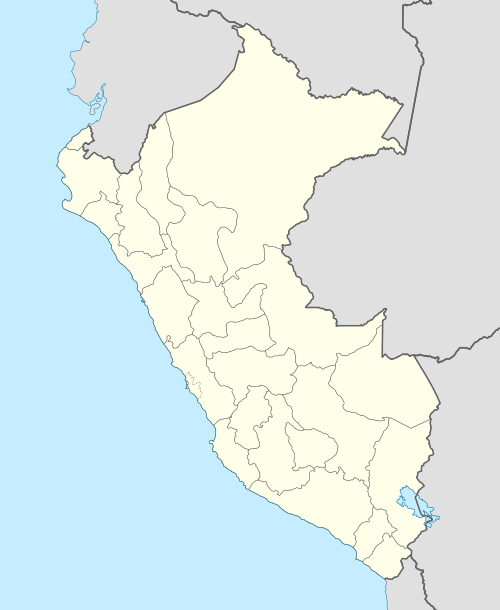Queshque
| Queshque | |
|---|---|
| Gueshgue, Pongos | |
 Queshque Peru | |
| Highest point | |
| Elevation | 5,630 m (18,470 ft) [1] |
| Coordinates | 9°46′28″S 77°14′51″W / 9.77444°S 77.24750°WCoordinates: 9°46′28″S 77°14′51″W / 9.77444°S 77.24750°W |
| Geography | |
| Location | Peru, Ancash Region |
| Parent range | Andes, Cordillera Blanca |
Queshque[2][3] (possibly from Quechua for a type of bromeliad[4]), or Gueshgue[1] is a 5,630-metre-high (18,471 ft)[1] mountain in the Cordillera Blanca in the Andes of Peru. It is situated in the Ancash Region, Huari Province, Chavín de Huantar District, and in the Recuay Province, Catac District.
The volume of mass loss of the three glaciers of Queshque has been documented recently.[2][3] The glaciers feed Lake Qishqiqucha via the Tranca Ruri river.[1]
The Austrian Alpine Club (OeAV) survey map represents Queshque as comprising three peaks with a different name each: Shahuanca, Jatunllacsa (the highest peak) and Gueshgue.[5] However, tourist maps of Cordillera Blanca show this mountain with the name of Pongos.[6]
References
- 1 2 3 4 Peru 1:100 000, Recuay (20-i). IGN (Instituto Geográfico Nacional - Perú).
- 1 2 Mark, Bryan G.; Seltzer, Geoffrey O. (2005). "Evaluation of recent glacier recession in the Cordillera Blanca, Peru (AD 1962–1999): spatial distribution of mass loss and climatic forcing". Quaternary Science Reviews. 24 (20–21): 2265–2280. doi:10.1016/j.quascirev.2005.01.003.
- 1 2 Stansell, Nathan D.; Rodbell, Donald T.; Abbott, Mark B.; Mark, Bryan G. (2013). "Proglacial lake sediment records of Holocene climate change in the western Cordillera of Peru". Quaternary Science Reviews. 70: 1–14. doi:10.1016/j.quascirev.2013.03.003.
- ↑ thefreelibrary.com New localities and taxonomic synopsis of Puya mima (Bromeliaceae), a charismatic and important Puya from Central Peru.: "... . Local people of this valley call it "queshque blanco", or the white Puya. ..."
- ↑ Alpenvereinskarte 0/3b. Cordillera Blanca Süd (Peru). 1:100 000. Oesterreichischer Alpenverein. 2005. ISBN 3-937530-05-3.
- ↑ Díaz, Felipe (2008–2009). Carta Turística. Cordilleras Blanca, Negra, Huayhuash y Callejón de Huaylas.
This article is issued from Wikipedia - version of the 8/6/2016. The text is available under the Creative Commons Attribution/Share Alike but additional terms may apply for the media files.